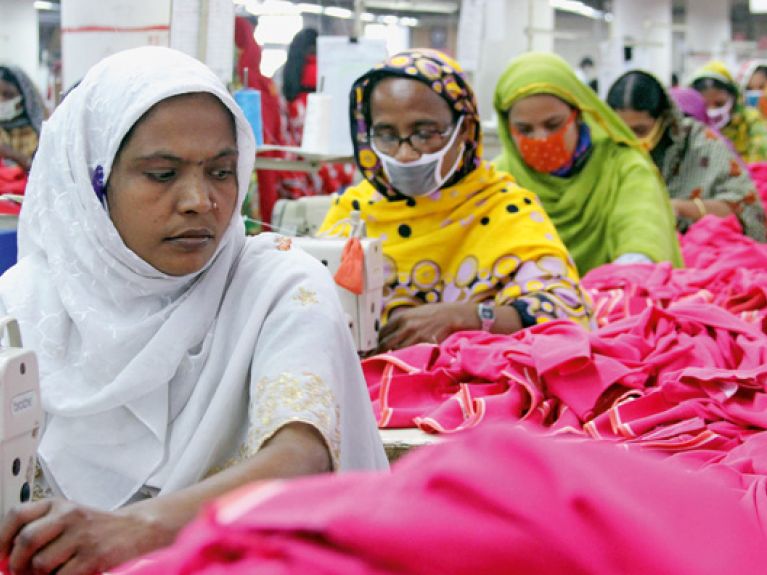Concerted action for fair and safe employment
Supply chains in the textile industry are complex and convoluted. Germany is actively working for greater transparency and relying on the power of alliances.

The pile of jeans resembles a bargain counter, until a foreman gathers up the trousers and takes them off to the pressing station. Zips, waistbands, labels – everything is already attached. The last seamstress in the line performs the same hand movement for the thousandth time. Every month, over 400,000 pairs of trousers move from sewing table to sewing table in this factory. The employees only talk about breaks and overtime in the protection of their homes. Very few of them know whether the factory is safe.
“Of course, we conduct regular fire drills,” says the factory operations manager. Located in Gazipur near Dhaka, the capital of Bangladesh, the plant manufactures clothes for the Pimkie brand. The man indicates the escape routes and the staircases where metal has now been replaced by heat-resistant concrete. The exits are unlockable. Deutsche Gesellschaft für Internationale Zusammenarbeit (GIZ) has improved fire prevention and building protection measures here on behalf of the German Federal Ministry for Economic Cooperation and Development (BMZ).
The factory is considered a model facility. It is one of many where the GIZ has provided advice on environmental and social issues. It may not be one of those ultramodern buildings you sometimes see in Asia, but then again it is not a shabby, flaky structure like the eight-storey Rana Plaza complex that collapsed in April 2013, burying over 1,100 people.
The serious accident revealed inhumane conditions in one Asian link of the textile industry supply chain. With just under four million workers, Bangladesh is the second largest producer in this sector after China. Since that fateful April 2013 a great deal has changed in politics and in the industry, in Berlin, Geneva and Dhaka – and yet it is still not enough.
First deficiencies found
Measured on a scale ranging from high-risk factory to high-gloss facility, today the production plant in Gazipur is probably in the top quarter. The production hall is well ventilated, none of the seamstresses sits wedged in between cardboard boxes and rolls of fabric, and everything looks tidy and spacious. And yet, inspectors working for Accord, a building standards watchdog used by 200 textile chains, found serious faults: switch cabinets under stairs, fuel stored too close to people and materials, an emergency exit blocked with waste – and the fire doors separating the hall from the stairs are inadequate. The faults have still not been rectified two years after the inspection. The factory is in default – like many others. Fire doors are expensive, and the lack of them is a chronic problem. The state of the factory in Gazipur proves that the textile industry’s problems will not be remedied as soon as some would like despite the rude awakening it received.
National laws are not enough
One of the impatient onlookers is Federal Development Minister Gerd Müller. When he visits Dhaka, as he did in October 2015, he meets politicians who are often also textile entrepreneurs themselves. “National laws alone achieve little when, for example, a men’s shirt passes through 140 different production steps on its way from the cotton field to the pressing station.” Müller takes the industry up on its promise. In Dhaka he visits a factory he has recruited as the first local member of the Partnership for Sustainable Textiles.
This partnership is an important element of the German effort in this field, alongside the cross-industry National Action Plan to implement the UN Guiding Principles on Business and Human Rights. After a difficult start in 2014, half of the German textile industry have now signed up: manufacturers like Adidas, retailers like C&A, non-governmental organisations, trade unions and business associations. A round table of relevant actors of this size has never existed before. And Germany is the largest clothing market in Europe.
All the members agree to satisfy jointly defined standards. They are currently working on individual roadmaps that outline the stages in which they aim to achieve social, ecological and economic goals for specific links in the supply chain: living wages, decontamination of the environment, due diligence obligations in procurement and more. All the homework is meant to be completed by the end of 2016, when there should also be clear rules on how improvements will be monitored, measured and published. It is reported that the talks sometimes get rather heated. The negotiations are secret – an easy target for critics, who have observed how the 65-page agreement presented in 2014 has been whittled down to just 11 pages. Some believe the plan has been sanitised. Political actors have indeed loosened its corset as the price of broadening participation: each company now defines its own targets and time frames.
From the industry’s perspective, anything else would have been unrealistic. The textile industry’s production chains are considered extremely complicated. Even a retailer like the Otto Group, which has paid attention to social and environmental issues for decades, is far from having a overall view of all the links in the chain. Transparency involves effort and is not available free of charge, says the Hamburg-based business that achieves ten billion euros of its turnover with textiles. So why take the trouble?
Achieving more together
“The charm of the partnerships lies in the fact that it combines forces that can effect greater changes together than individual actors could ever achieve alone,” says Andreas Streubig, Head of Division for Sustainability Management at the Otto Group. He refers to Accord as an example. The alliance shows that concerted action can pressure government, associations and factory owners to act. “It is only as a result of this that substantial changes have occurred.”
Streubig expects the textiles partnership to have “tangible effects on the way we run our business”. The Executive Board will have to introduce new mechanisms into supply chains that make them “seamlessly transparent and, above all, controllable” if it wants to achieve a goal like exclusively using sustainable cotton by 2020. This means establishing responsibility for standards in such a way that each stage is liable for the respective preliminary stage. These are called “chains of custody”. Whether the nearly one hundred firms in the partnership can ultimately guarantee that their products involve decent work remains doubtful. “I consider 100% sustainability an illusion,” says Streubig. “Being able in the next five years to monitor the path of a shirt through all the steps of the value chain from cotton field to customer to ensure that everything is sustainable will be a great challenge.” What he considers decisive, however, is the fact that companies are setting out to steadily reduce the grey areas.
Reducing grey areas is also something the leading industrialised nations have pledged to do. At the G7 summit under German Presidency in June 2015 the heads of state and government made a promise: they said they would campaign for sustainable supply chains and the improved implementation of employment, social and environmental standards, for example, through national action plans. In the concluding Leaders’ Declaration, participants urged “private sector implementation of human rights due diligence”. Speaking at the follow-up conference of G7 employment and development ministers in Berlin, Gerd Müller said Germany was a trailblazer on the path to fair standards in global supply chains. Frank Zach, Asia expert of the Confederation of German Trade Unions, said the fact that working conditions became a G7 topic at all and would now also occupy the emerging countries was exceptional in itself. “Until then the problem of supply chains had never been addressed in a global context.” The good intentions now have to be put into practice. This will be achieved with the aid of the planned Vision Zero Fund, among other things.
Culture of occupational safety
The fund’s underlying idea is the assumption that a culture of occupational safety must flower in the plants themselves. Funding has already been planned in 2016 for the first projects in the clothing sector, which are being organised jointly by government and the two sides of industry: safety at work committees are to be established and occupational cooperatives set up. Governments and companies can pay into the fund, which will be administered by the ILO. Its Better Work programme has also been trying for some time to convince policymakers in Bangladesh to take occupational safety more seriously.
In Bangladesh, Germany is helping to train more government inspectors through the GIZ. After all, there are still unfilled vacancies. Canada, the Netherlands and the UK have already financed a first round of inspections through the ILO: today, no longer just 20, but nearly 300 government engineers are struggling their way through the traffic jams of Dhaka on their motorbikes – metre by metre, factory by factory, inspection by inspection.
Nevertheless, the consequences for building safety remain within certain limits. With regard to Bangladesh, the ILO recently reported rather matter-of-factly: “Establishing a culture of health and safety at work and implementing it with trained personnel is a great challenge.” ▪

